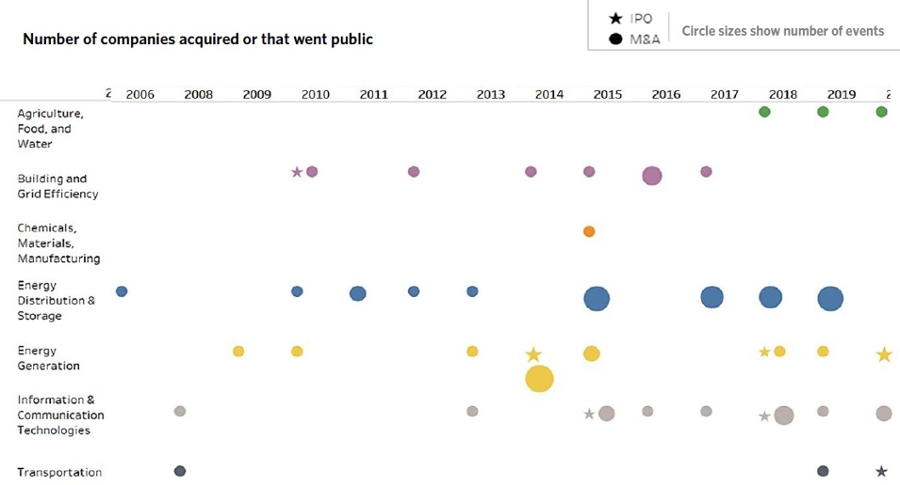The startup companies combating climate change in the Northeast are clustered in big cities, span a wide array of industries and are led by an increasingly diverse group of executives, according to a new report by researchers at Brandeis International Business School.
The Climate Innovation in the Northeast, 2000-2020 report presents new data on the companies and people addressing a wide variety of climate challenges — from renewable energy generation and distribution, to food and waste, new materials, transportation and more. The report examines the activity of 494 startups created in New England and New York over the last two decades, as well as the gender and ethnic identities of the companies’ founders and top managers.
“Our micro-level data show that the business of climate change is becoming more diverse in its industrial activities and in the people who lead it,” said Ben Gomes-Casseres ’76, the Peter A. Petri Professor of Business and Society and the report’s lead researcher. “Climate tech has grown over time to include more solutions and business segments, and its leaders have gradually included more women and minorities. But there is much to do if this industry is to truly become everyone’s business.”
The report was released April 15 in conjunction with the International Business School’s second-annual Business of Climate Change program, and is co-sponsored by the Asper Center for Global Entrepreneurship and the Northeast Clean Energy Council (NECEC).
"We're trying to grow the clean energy economy in the Northeast," said Alistair Pim, vice president of innovation and partnerships at NECEC. "This study has really given us a new lens to see what's happening out there."
Here are seven insights from the Climate Innovation report.

This chart shows where companies are located, with the dot size proportional to the number of companies in that location. The companies are mostly located in large and mid-size urban centers, with the bulk located in the Boston area and New York City. The remaining companies are spread out evenly across all states in the region.
"This is very much a Boston-New York corridor," said Gomes-Casseres. "Over 80 percent of companies in our data are headquartered in these metropolitan areas."

This chart shows the number of companies in each of the sectors and subsectors used by the researchers. The research team found that newer “climate tech” sectors like Agriculture, Food and Water; Chemicals, Materials and Manufacturing; and Information and Communication Technologies now have as many companies as longer-established “clean energy” sectors like Energy Generation; Energy Distribution and Storage; and Building and Grid Efficiency.

The researchers found that most of the companies have under 50 employees — and many have under 10. However, the bulk of total employment is in companies with over 50 employees and the total employment in these startups is close to 15,000.

This chart shows how many companies still active in 2020 were founded in each prior year. The pace of new company formation rose rapidly in the five-year period beginning in 2005. From 2010 onward, the pace of new company formation remained high, with moderate ups and downs.
"It's been bumpy," said Pim. "Innovation in clean energy, in particular, takes time because it's a regulated industry."
The researchers explained that data on startups in the last couple of years are incomplete because new companies often do not yet show evidence of business activity, such as revenue or funding.

This chart shows the number of companies that were acquired or went public since 2005. In all, the researchers noted 52 acquisitions and nine initial public offerings (IPOs). There has been a sustained pace of acquisitions and IPOs in core “clean energy” sectors, while acquisitions and IPOs increased in other “climate tech” sectors in later years.

These charts show the gender breakdown of leadership positions, including founders, top management and some middle management. Over the last two decades, only 17 percent of these roles were occupied by women. But the share of women leaders gradually increased in recent years, reaching 25 percent in companies founded between 2016 and 2020.
Gomes-Casseres said the diversity statistics are not where they should be, although the trend over the last five years represents a positive sign.
“I think it’s something that we all want to see change,” he said.

These charts show the shares of ethnic groups in leadership positions. On average, ethnic minorities represented 22 percent of overall company leadership over the last two decades. Similar to the gender statistics, the share of ethnic minorities has also increased recently — reaching 30 percent over the last five years. During the same period, the share of minorities plus women reached 42 percent.
“It’s something we’re working really hard to improve by reaching out to new networks,” said Pim. “We want everyone involved. Let’s keep this trend going.”
Read the full Climate Innovation in the Northeast, 2000-2020 report.
Featured Stories
News Categories
@BrandeisBusiness Instagram
View this profile on InstagramBrandeis Intl. Business School (@brandeisbusiness) • Instagram photos and videos